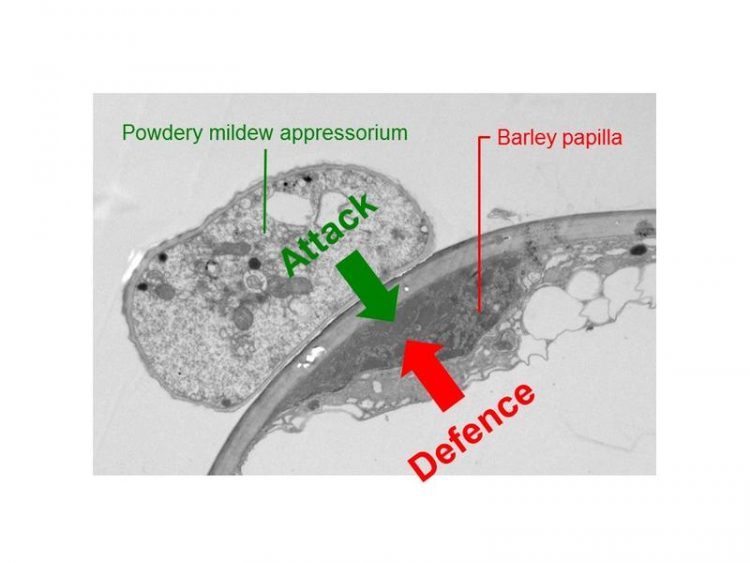Fungal intruder ante portas!

Electron microscopic image of barley papilla and powdery mildew appressorium. Twan Rutten/ IPK
An international research team with participation of the Leibniz-Institute of Plant Genetics and Crop Plant Research (IPK)/ Germany and the University of Adelaide/ Australia has provided new targets for the generation of enhanced disease resistance against the powdery mildew pathogen in barley.
Until now the role of the cell-wall components callose and cellulose in penetration resistance of crop species have been largely unknown, because the genes involved in the observed callose and cellulose accumulation have not been identified unequivocally.
By silencing of the HvCslD2 or the HvGsl6 gene the research team has shown that its down regulation is associated with lower accumulation of callose as well as cellulose and higher susceptibility of barley plants to penetration by the fungal pathogen. This indicates that callose and cellulose contribute to the barley fungal penetration resistance.
In the plant and pathogen co-evolutionary battleground, host plants have evolved a wide range of defence strategies against attacking pathogens. One of the earliest observed defence responses is the formation of cell-wall thickenings called papillae at the site of infection. The papillae are cellular reinforcements formed by depositing polysaccharides between the wall and the plasma membrane.
In case of barley, which was the main focus of the study, the papillae contain callose and cellulose beside other polysaccharides. It was already known that overexpression of the stress-induced callose synthase gene AtGsl5 from the model plant Arabidopsis induced penetration resistance to the powdery mildew pathogen. The research team expected, that there would be an AtGsl5 ortholog present in most monocot species like barley that might mediate callose accumulation during fungal infections.
Thus they employed a comparative genomics approach between Arabidopsis and a series of representative monocot species including barley. A phylogenetic analysis revealed that the gene HvGsl6 has close sequence similarity with AtGs15.
Transcript profile analysis and transient-induced gene silencing showed that the HvGsl6 transcript is significantly upregulated following powdery mildew infection and that reduced HvGsl6 transcript levels lead to both, decreased accumulation of callose in the papillae and increased susceptibility of barley against the well adapted fungal pathogen.
Very similar results were obtained by silencing a second gene, HvCslD2, which encodes for the cellulose-synthase like protein D2 of barley. Here, the level of accumulating cellulose was reduced and plants suffered not only from enhanced infection by the barley- but also from the wheat powdery mildew, for which barley is normally not a host. In line with the proposed protective function of HvCslD2 in barley its over-expression enhanced resistance.
“The association of the plant cell wall with fungal penetration resistance provides new targets for the improving disease resistance in cereal crops. The identification of the genes involved in the biosynthesis of each papilla component is a major step towards achieving this goal says Dr Alan Little, Senior Research Scientist with the ARC Centre of Excellence in Plant Cell Walls, at the University of Adelaide.
“Our results show that the novel gene HvCslD2 is an interesting target for improving disease resistance in barley and maybe other cereals. It probably acts by making cell-walls of the “plant fortress” less easily penetrated by fungal pathogens ante portas. Now we have to find beneficial alleles for this gene for introgression into modern barley” explains Patrick Schweizer, head of the Pathogen-Stress Genomics lab at the Leibniz-Institute of Plant genetics and crop Plant Research (IPK) in Gatersleben.
Publications:
Douchkov, D., Lueck, S., Hensel, G., Kumlehn, J., Rajaraman, J., Johrde, A., Doblin, M. S., Beahan, C. T., Kopischke, M., Fuchs, R., Lipka, V., Niks, R. E., Bulone, V., Chowdhury, J., Little, A., Burton, R. A., Bacic, A., Fincher, G. B. and Schweizer, P. (2016), The barley (Hordeum vulgare) cellulose synthase-like D2 gene (HvCslD2) mediates penetration resistance to host-adapted and nonhost isolates of the powdery mildew fungus. New Phytol. doi:10.1111/nph.14065
(URL: http://onlinelibrary.wiley.com/doi/10.1111/nph.14065/epdf)
Chowdhury J., Schober M.S., Shirley N.J., Singh R.R., Jacobs A.K., Douchkov D., Schweizer P., Fincher G.B., Burton R.A. and Little A. (2016). Down-regulation of the glucan synthase-like 6 gene (HvGsl6) in barley leads to decreased callose accumulation and increased cell wall penetration by Blumeria graminis f. sp. hordei. New Phytol. doi: 10.1111/nph.14086
(URL: http://onlinelibrary.wiley.com/doi/10.1111/nph.14086/epdf)
Further Information:
Dr. Patrick Schweizer, Leibniz Institute of Plant Genetics and Crop Plant Research (IPK), OT Gatersleben, Corrensstrasse 3, D-06466 Seeland, schweizer@ipk-gatersleben.de
Dr Alan Little, University of Adelaide, Adelaide, Australia, alan.little@adelaide.edu.au
Press Contact:
Dr. Sabine Odparlik, Leibniz Institute of Plant Genetics and Crop Plant Research, OT Gatersleben,
Corrensstrasse 3, D-06466 Seeland, odparlik@ipk-gatersleben.de
http://onlinelibrary.wiley.com/doi/10.1111/nph.14065/epdf
http://onlinelibrary.wiley.com/doi/10.1111/nph.14086/epdf
Media Contact
All latest news from the category: Agricultural and Forestry Science
Newest articles

Silicon Carbide Innovation Alliance to drive industrial-scale semiconductor work
Known for its ability to withstand extreme environments and high voltages, silicon carbide (SiC) is a semiconducting material made up of silicon and carbon atoms arranged into crystals that is…

New SPECT/CT technique shows impressive biomarker identification
…offers increased access for prostate cancer patients. A novel SPECT/CT acquisition method can accurately detect radiopharmaceutical biodistribution in a convenient manner for prostate cancer patients, opening the door for more…

How 3D printers can give robots a soft touch
Soft skin coverings and touch sensors have emerged as a promising feature for robots that are both safer and more intuitive for human interaction, but they are expensive and difficult…





















